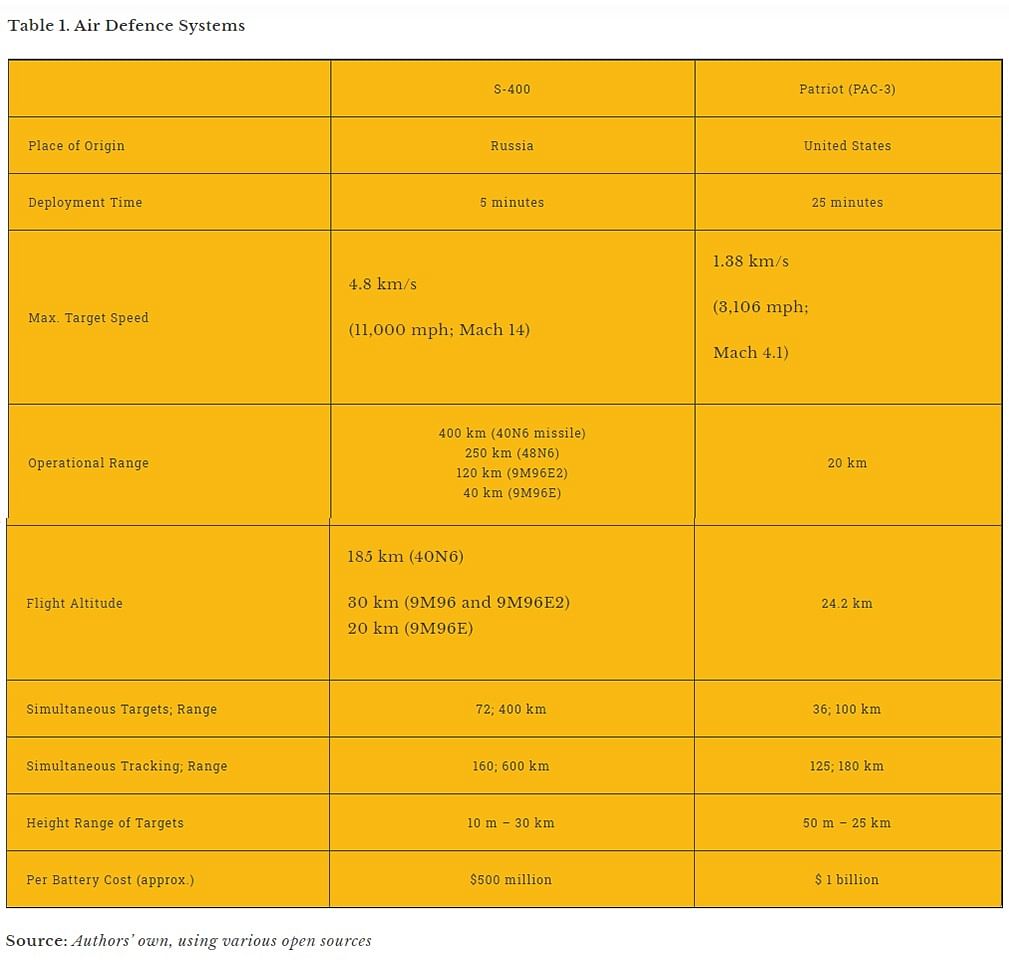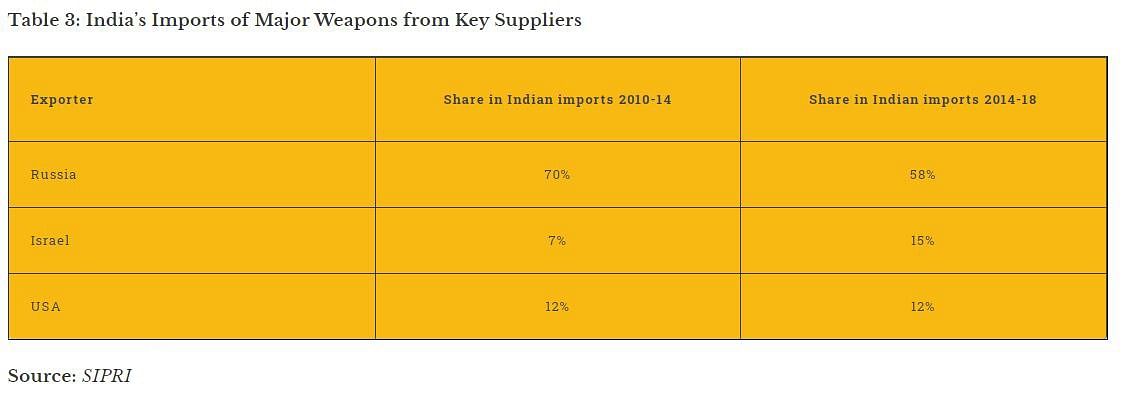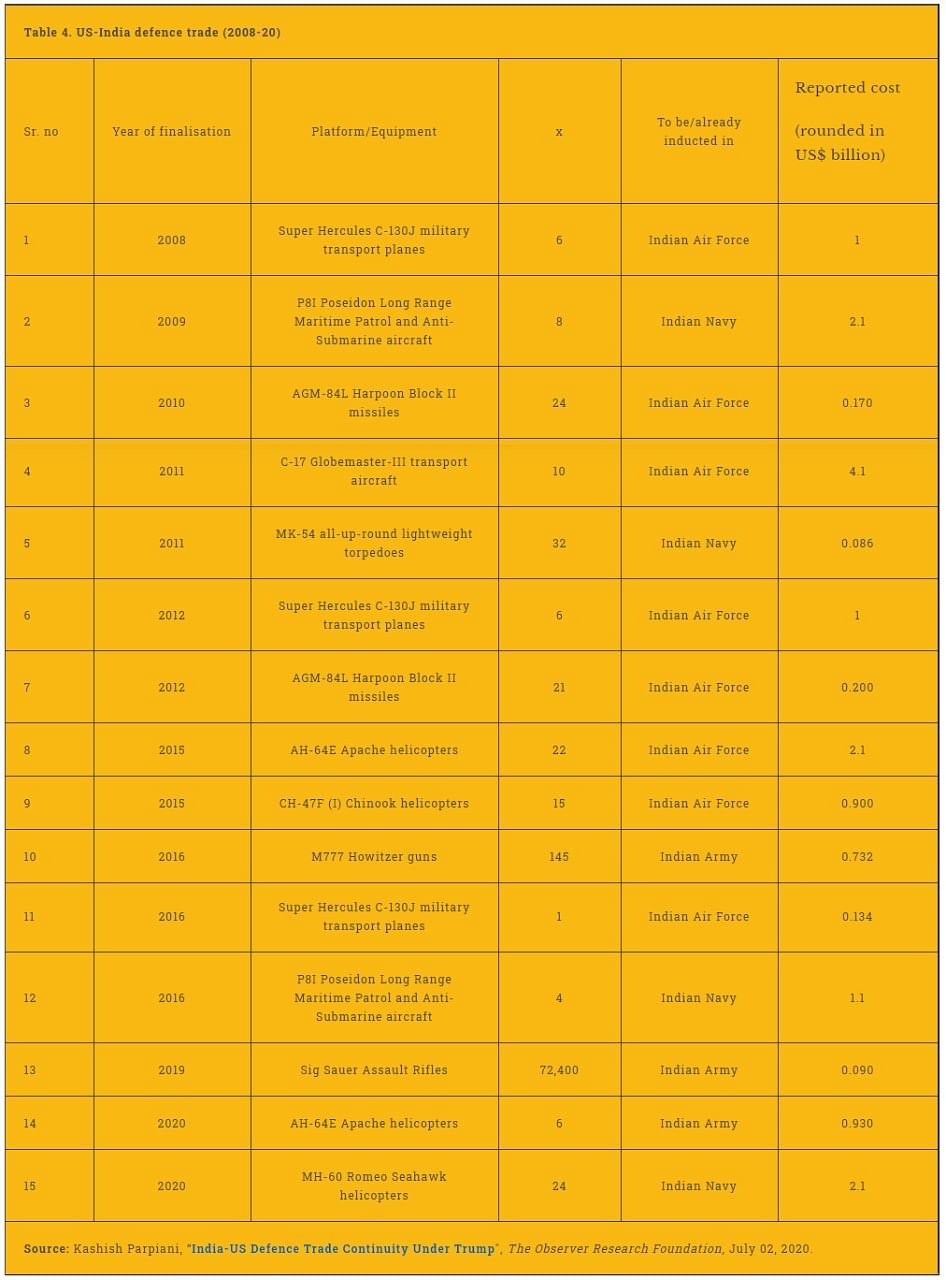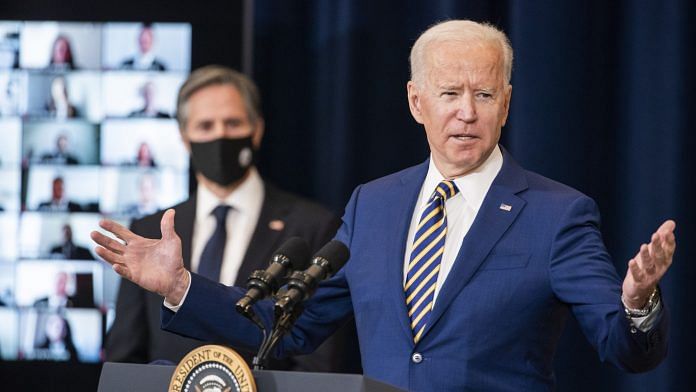The first Indian military team has left for Russia to commence training on the S-400 air defence system, deliveries of which are expected to begin in end-2021. This event has once again thrown into sharp focus the friction that India’s enduring defence relationship with Russia creates with India-US bilateral ties. Days before the Indian team headed out, sanctions under the Countering America’s Adversaries Through Sanctions Act (CAATSA) were applied to Turkey for procurement of the same system.
Yet New Delhi appears determined to proceed with the $5.2-billion deal, having concluded that the S-400 was cost-effective and will be efficient in meeting India’s defence needs as compared to rival systems. The Indian government has stressed that negotiations were already underway before CAATSA came into being in 2017, with the Inter-governmental Agreement (IGA) for its procurement having been signed in 2016 during the 17th India-Russia summit in Goa. The contract for its supply was concluded in 2018, and in recent years, India and Russia have signed a number of additional defence deals across domains, including guided missile frigates, T-90 battle tanks, and lease of a nuclear-powered attack submarine.
Given the breakdown of relations between the US and Russia, any decision on the matter under discussion will be an either/or choice for the US: between playing hardball with Moscow, and preserving its steadily growing ties with New Delhi. Amid this conundrum, even as the Biden administration signals its continued commitment to the Act, we underline reasons – military, political, economic and strategic – that ought to make India eligible for a waiver, the Russia factor notwithstanding.

Also read: India-Russia ties strong enough to navigate world’s complexities — Foreign Secretary Shringla
S-400 and the CAATSA Contention
From the Indian Air Force perspective, there is no alternative system capable of serving its long-range air defence requirements, from the standpoint of either capability or cost. The ability of the S-400 to constrain the adversary’s air operations even within their own airspace, is unmatched by typical Western systems offered up as analogues. While the S-400 is optimised primarily for long-range prosecution of high-value aircraft targets with a secondary missile defence capability, Western systems like the MIM-104 Patriot are primarily oriented toward missile defence with less focus on the pure anti-aircraft role. The S-400 compares favourably on the cost front as well, with typical configurations costing around half of their western equivalents—it is an important consideration as the Indian Air Force struggles to spread limited modernisation funding across a multitude of operational imperatives, including air defence, manned tactical aircraft, force multipliers, and utility aircraft.

On the other hand, it is apparent that US concerns go beyond just CAATSA and Russian arms sales. The presence of advanced systems such as the S-400 among US allies will clearly impede certain technology transfers and joint operations, as evidenced by the immediate suspension of F-35 deliveries to NATO ally Turkey, even before sanctions under CAATSA came into force. Turkey has also been removed from the multinational F-35 development and production programme. In the US-India case, where the countries are not formal allies, the S-400 will nevertheless place constraints on some contours of what the US envisions for the future of the US-India defence relationship.
While CAATSA does provide for waivers, acknowledging that there will be friendly countries with little choice but to continue dealing with proscribed Russian entities, there is no room for a “blanket exception” of the sort that might entirely insulate countries like India.
Notwithstanding a few key acquisitions, Russia’s overall share of Indian defence imports has been steadily declining. At the same time, the India-US defence relationship has steadily heightened, particularly over the last decade. The same is true of Indian relations with the West and US-allied nations in general, with a significant uptick in imports from Europe and Israel in recent years, in addition to greater cooperation at the operational level. India conducts very few military exercises with Russia in comparison to those with the US, Europe, Japan, and Australia. Indo-Russian exercises also tend to be far less complex, with less focus on interoperability.
Also read: India gets Ukrainian engines for its stealth frigates, sends them to shipbuilder in Russia
The post-Soviet era
58 percent of India’s arms imports still come from Russia and estimates of Russian-origin platforms in the military range from 60 to 85 percent. SIPRI estimates that Russia has supplied India with arms worth $40 billion since 1991. However, Russian officials have pegged the total volume of contracted products in the same period at $70 billion. The scope of this relationship makes it both unrealistic and unwise to expect India to suddenly break off ties with Russia, or to diversify at a rapid pace – this would leave its defences vulnerable in a volatile neighbourhood.
This does not mean that India only sources its arms import needs from Russia. SIPRI data suggests that while Russia supplied 58 percent of total arms imports by India in 2014-18, this was a step down as compared to 76 percent in 2009-13.
Also read: India stocks up missile arsenal as it prepares for another tense summer in Ladakh
Continuing ‘special and privileged strategic partnership’
The defence relationship, in the absence of a flourishing economic base to the India-Russia strategic partnership, has come to form the bedrock of bilateral ties alongside energy cooperation. At a time when Indian and Russian foreign policies are adjusting to the changing balance of power in the international system, their continued engagement acquires a distinct strategic undertone.
Russia has registered a qualitative improvement in ties with China, turning to the rising power as its relations with the West have reached a new post-Cold War low. At present, Russia might not be able to “help India balance China” and this forces India to seek other partners. However, there is recognition that pushing Russia into an even closer partnership or worse, an alliance with China, would strengthen the rising power and undermine India’s interests. And while India has been growing closer to the US as it seeks to manage an increasingly aggressive China in its neighbourhood, it is as yet unwilling to sacrifice its strategic autonomy in policy decision-making. Russia, while building its relations with China, is equally reluctant to become a junior partner and seeks to follow a multi-vector policy that would position itself as a significant player in global affairs.
This provides an opening and a rationale for India to maintain close ties with Russia. The two countries also share ideas of a multipolar world and have common concerns that constrain their policy actions in Eurasia, including the threat of terrorism, regional instability and the impact of US-China bipolarity. To be sure, there is no denying some concern in recent past on Pakistan and divergences regarding ongoing closer military engagement between Moscow and Beijing, and Russian opposition to the concept of Indo-Pacific. However, these have not been allowed to overtake the bilateral agenda. Instead, the engagement has remained steady, with Defence Minister Rajnath Singh visiting Russia in June 2020 for the 75th Victory Day parade. The visit also served to further the defence ties. Russia assured India of meeting its defence supplies needs and promised to expedite delivery where possible, while assuring that weapons would not be supplied to Pakistan. Some months later, in September, Moscow hosted the first meeting between Indian and Chinese defence ministers since clashes on the eastern Ladakh border, on the sidelines of SCO Defence Ministers’ Meeting.
Thus, for India, relations with Russia remain a priority and continued defence engagement is a vital part of this “special and privileged strategic partnership.” In such a situation, threat of sanctions from the US is unhelpful as it impinges on India’s efforts to maintain a diversified portfolio of ties in order to further its national interests. While India is naturally expanding its defence ties with other countries, the use of sanctions by Washington will likely hurt the interests of a close US partner, rather than Russia.
As India continues to improve its relations with the US, realising the importance of this bilateral engagement for dealing with the changing international order and strengthening its global standing, it remains aware that defence ties with Russia will remain crucial in the immediate future. Given the billions of dollars’ worth of defence orders already given and those in process of being executed, Indo-Russian defence relations are set to continue for the coming years.
New Delhi would of course benefit from a situation where Moscow’s ties with the West are more stable. But given that is unlikely in the short to medium term, India sees no valid reason to further isolate Russia by delinking from its strategic partner, especially when it comes to defence supplies. India and Russia are not involved in a direct conflict with each other, and a trusted relationship has been maintained in arms supplies. As long as the relationship continues to meet the standards of achieving common interests through pragmatic bilateral engagement, the defence pillar of their partnership will sustain itself. This means that concerns about sanctions under CAATSA are unlikely to go away any time soon, as the relevance of the legislation under the Biden administration looks set to continue.

Also read: Moscow’s relationship with China, Pakistan independent of its ties with India — Russian envoy
Risking India-US business
Despite momentary frictions or even a “very mild” imposition of CAATSA sanctions against India, one may argue that the Biden administration will eventually recognise that penalising India for serving a part of its military modernisation needs through Russia would put at risk ongoing and potential India-US defence business worth several billion dollars. The US as a strategic partner must appreciate that the extent of India-Russia defence ties means these relations cannot be wished away.
While India has begun a gradual process of diversifying its arms imports, this process can only take place incrementally. In such a scenario, the use of secondary sanctions is more likely to be perceived as an infringement on India’s strategic autonomy and would also cause the bilateral relationship to crater. The Biden administration could face serious Congressional pushback since support for US-India ties continues to invite bipartisan support even in these times of increased partisanship on US foreign policy. It may also jeopardise Biden’s stated intent to practise continuity on the Indo-Pacific strategy, where India occupies a central role in the US’ security calculus.

Moreover, under the aegis of its ‘Act East’ policy, India has made progress towards integrating itself into the US’ Indo-Pacific calculus. This has encompassed gradually shedding its historic focus on westward security apprehensions and instituting an eastward security outlook—with India’s Ministry of External Affairs now having an Indo-Pacific division; engaging in naval sailings with like-minded partners in the South China Sea; and assuming the mantle of being the Indian Ocean’s preeminent net security provider with the establishment of the Information Fusion Centre – Indian Ocean Region (IFC-IOR) for comprehensive maritime domain awareness. This adds credence to New Delhi’s case for receiving a CAATSA waiver, as cooperation on security matters that are critical to US strategic interests is a criterion under Section 231(d) waiver provisions. Therefore, in re-strategising its outreach to relevant stakeholders of the 117th US Congress and the Biden administration, New Delhi would do well to make a case for a waiver based on its robust record in assisting US strategic aims in the Indo-Pacific.
Furthermore, a comparison of the overall trajectories of India-Russia and India-US defence ties illustrates how India stands apart from Turkey on the applicability of CAATSA sanctions. India has reduced its arms imports from Russia, a trend that precedes CAATSA as it diversifies its supplies. This also brings it in line with the first criteria under Section 231(d) waiver provisions, on demonstrating credible action on gradually reducing the share of Russian defence equipment and advanced conventional weapons in its arsenal. Turkey, on the other hand, despite being a NATO ally and partner in one of the most significant US-led military programmes, the F-35, broke bilateral precedents by selecting the S-400. So far as India continues to reduce reliance on Russia, whether through indigenous capacity or diversified sources of supply, it should be treated as distinct from cases like Turkey’s, allowing it to deal in good faith with both of its principal defence partners.
Kashish Parpiani @kparpiani is a Fellow at ORF, Mumbai. Nivedita Kapoor @niveditakapoor is a Junior Fellow at ORF. Angad Singh @zone5aviation is Project Coordinator at ORF. This report was compiled with assistance from Javin Aryan, Research Intern at ORF. Views are personal.
The article has been extracted from a report titled ‘India’s Purchase of the S-400: Understanding the CAATSA conundrum.’ Read the full report here.







India need to continue its policy of strategic autonomy and maintain its geo political and geo economic goals.The quad can be pursued as an counter foil to china as long as US understands and respects India’s goals. China can not be trusted at all and as such there there is no place for any peace inititive with China.India need to be very watchful and be absolutely prepared for a repeat of Galwan again by China.
The US sees arms sales to India as a higher priority than the Indo-Pacific vision. India should not plead for the US to be more reliable and take the Indo-Pacific more seriously. Instead, make peace with China and forget the Indo-Pacific altogether.